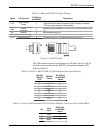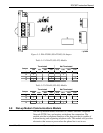
ROC827 Instruction Manual
Issued Mar-06 Communications 5-9
greater than 400°C (752°F), use plenum rated cables to ensure that cable
attenuation remains within specification.
When connecting two twisted-pair Medium Attachment Units (MAUs) or
repeaters together over a segment, wire the transmit data pins of one eight-
pin connector to the receive data pins of the other connector, and vice
versa. There are two methods for accomplishing 10BASE-T crossover
wiring:
Using special cable.
Wiring the 10BASE-T crossover inside the hub.
For a single segment connecting only two devices, provide the signal
crossover by building a special crossover cable, wire the transmit data pins
of one eight-pin connector to the receive data pins of the other connector,
and vice versa. Refer to Figure 5-4.
Signal Signal
Pin 1 TD+ Pin 1 TD+
Pin 2 TD– Pin 2 TD–
Pin 3 RD+ Pin 3 RD+
Pin 6 RD– Pin 6 RD–
Figure 5-4. 10BASE-T Crossover Cable
5.7 EIA-232 (RS-232) Serial Communications
The built-in EIA-232 (RS-232), the LOI, and the communication modules
meet all EIA-232 (RS-232) specifications for single-ended, asynchronous
data transmission over distances of up to 15 meters (50 feet). EIA-232
(RS-232) communication provides transmit, receive, and modem control
signals. The LOI port also meets EIA-232D (RS-232D) specifications.
The EIA-232 (RS-232) communications have the following
communication port designations in ROCLINK 800.
LOI – Local Port EIA-232 (RS-232D). Refer to Section 5.5, “Local
Operator Interface.”.
Built-in – Comm2 EIA-232 (RS-232C).
Module – Comm3 to Comm5 EIA-232 (RS-232C).
EIA-232 (RS-232) uses point-to-point asynchronous serial
communications and is commonly used to provide the physical interface
for connecting serial devices, such as gas chromatographs and radios to
the ROC800-Series. The EIA-232 (RS-232) communication provides
essential hand-shaking lines required for radio communications, such as
DTR and RTS.


















